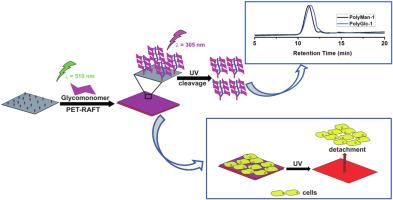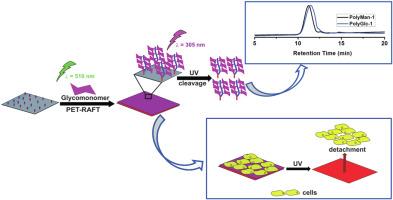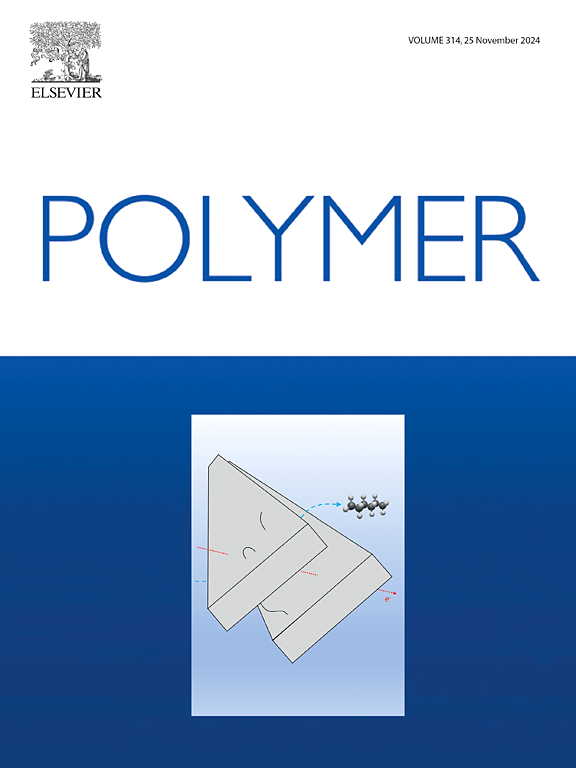基于可控光导接枝/脱落策略的糖聚合物刷的综合表征
IF 4.1
2区 化学
Q2 POLYMER SCIENCE
引用次数: 0
摘要
在此,我们提出了一种利用表面诱导光诱导电子/能量转移-可逆加成-断裂链转移(SI-PET-RAFT)聚合法在玻璃基底上自主调节糖聚合物刷构建和裂解的策略。该工艺包括用光可裂解分子处理链转移剂,并用 3-氨基丙基三乙氧基硅烷(APTES)将其连接到玻璃基底上。以 ZnTPP 作为光催化剂,聚合反应在 510 纳米波长下开始,糖聚合物刷可在 305 纳米波长的光下分离。这使得 GPC 和 NMR 表征成为可能,并证明了Đ <1.2的可控聚合物结构。与非聚糖表面相比,表面形成的聚糖(包括 D-葡萄糖和 D-甘露糖基聚合物)可增强 NCM460 细胞的粘附力,从而实现精确的细胞粘附和分离。这表明它有可能应用于组织工程。本文章由计算机程序翻译,如有差异,请以英文原文为准。


Comprehensive characterization of glycopolymer brushes based on controlled light-directed grafting/detachment strategy
Herein, we present a strategy for the autonomous regulation of glycopolymer brush construction and cleavage on glass substrates using surface-initiated photoinduced electron/energy transfer-reversible addition-fragmentation chain transfer (SI-PET-RAFT) polymerization. This process involves treating the chain transfer agent with a photocleavable moiety and linking it to glass substrates using 3-Aminopropyl triethoxysilane (APTES). Polymerization initiates at 510 nm with ZnTPP as a photocatalyst, and the glycopolymer brushes can be detached with 305 nm light. This allows GPC and NMR characterization, demonstrating controlled polymer structures with Đ <1.2. Glycopolymers formed on the surface, including d-glucose and d-mannose based polymers, enhance NCM460 cell adhesion compared to non-glycopolymer surfaces, enabling precise cell adhesion and detachment. This suggests potential applications in tissue engineering.
求助全文
通过发布文献求助,成功后即可免费获取论文全文。
去求助
来源期刊

Polymer
化学-高分子科学
CiteScore
7.90
自引率
8.70%
发文量
959
审稿时长
32 days
期刊介绍:
Polymer is an interdisciplinary journal dedicated to publishing innovative and significant advances in Polymer Physics, Chemistry and Technology. We welcome submissions on polymer hybrids, nanocomposites, characterisation and self-assembly. Polymer also publishes work on the technological application of polymers in energy and optoelectronics.
The main scope is covered but not limited to the following core areas:
Polymer Materials
Nanocomposites and hybrid nanomaterials
Polymer blends, films, fibres, networks and porous materials
Physical Characterization
Characterisation, modelling and simulation* of molecular and materials properties in bulk, solution, and thin films
Polymer Engineering
Advanced multiscale processing methods
Polymer Synthesis, Modification and Self-assembly
Including designer polymer architectures, mechanisms and kinetics, and supramolecular polymerization
Technological Applications
Polymers for energy generation and storage
Polymer membranes for separation technology
Polymers for opto- and microelectronics.
 求助内容:
求助内容: 应助结果提醒方式:
应助结果提醒方式:


